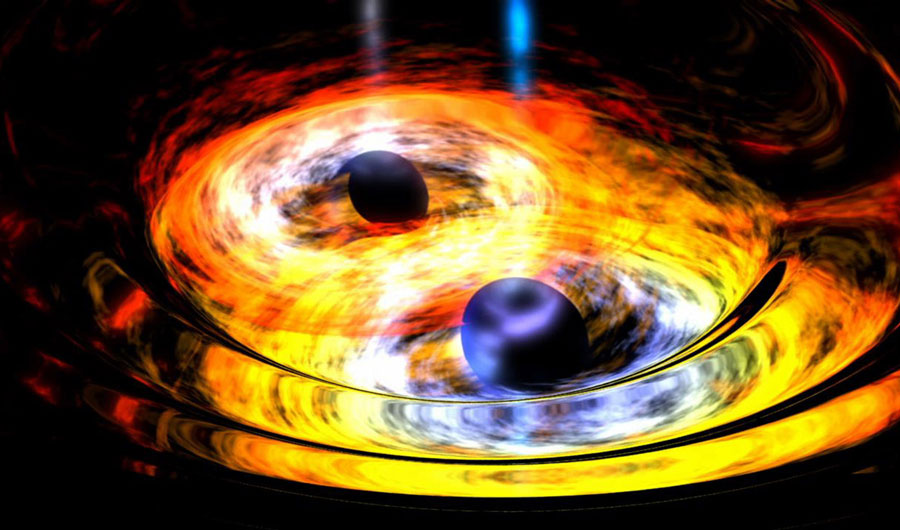Upgraded LIGO Detector Could See Black Holes Being Thrown Out of Galaxies

An artist's depiction of two black holes in the process of merging with each other.
(Inside Science) -- When a bullet is fired from a gun, the gun recoils to compensate for the bullet’s momentum. This conservation of momentum still applies when the most massive objects in the universe -- black holes -- collide and merge with each other. During these mergers, recoils can be powerful enough to send the merged black hole flying out of its home galaxy, at speeds of up to 10,000,000 miles per hour.
This recoil of the merged black hole is fittingly called a “kick.” Astronomers have known about this phenomenon for decades based on predictions from Einstein’s theory of general relativity, but haven’t managed to observe it yet. However, a brand-new way to analyze gravitational waves could make kick detections possible much sooner than scientists previously thought, according to recent research published in the journal Physical Review Letters.
Deciphering the signal
The first observation of gravitational waves -- the ripples in space-time created by massive objects orbiting and colliding with each other -- was a lauded scientific feat that won the Nobel Prize in physics in 2017. The experiment that made the detection, the Laser Interferometer Gravitational-Wave Observatory (LIGO), made incredibly delicate measurements to detect the extremely subtle changes in space-time created when two black holes merge.
Theorists think there are a lot more activities in the universe generating gravitational waves that LIGO isn’t sensitive enough to observe yet, such as the massive kick from a black hole merger. The gravitational wave signature of these activities is subtle enough that LIGO can’t tell it apart from experimental noise. But armed with a new signal analysis method, the next upgraded version of LIGO may change the game.
“Previous estimates were that the current generation of LIGO detectors would not be able to do this,” said Leo Stein, a professor at the University of Mississippi. “But this new research, by using more sophisticated models, demonstrated that it should actually be possible with this present generation of detectors after they get upgraded.”
Researchers Vijay Varma, Maximiliano Isi and Sylvia Biscoveanu, from Caltech and the LIGO group at MIT, analyzed thousands of simulations of black hole mergers, modeling the predicted kick and gravitational wave signal for each one. This analysis allowed them to devise a method to extract the kick’s direction and speed from the kind of signal that LIGO would detect.
“Given a gravitational signal, we can predict the velocity of the final black hole,” said lead researcher Varma, a postdoctoral researcher at Caltech in Pasadena, California, who will be moving to Cornell University in Ithaca, New York, later this year. “And if it is moving faster than the escape velocity of the galaxy, we know it will escape the galaxy eventually.”
Giving astronomy research a “kick”
Aside from its contribution to black hole research, the ability to measure these “kicks” would also affect research on galaxy evolution and the theory of general relativity.
“This [recoil] is one of the cleanest predictions of general relativity,” said Will Farr, an astrophysicist at Stony Brook University in New York. “General relativity is complicated, but it still conserves momentum. If the kick observations don’t match theory, then we’ll have to wonder where that momentum goes. And that's a very exciting possibility.”
For researchers studying how galaxies form, the number of black holes being regularly expelled from galaxies is an important quantity to consider.
“If it turns out that there are a lot of these mergers where the recoil is really large, we’ll know that a lot of the black holes are being ejected,” Varma said, “and the evolution of the galaxy itself can be affected by that.”
Kick observations could also provide insight into how larger black holes form. Currently, it’s theorized that most black holes were once stars that went supernova, which implies that it would be very difficult to form a black hole heavier than 50 solar masses -- but LIGO has already detected one of these heavyweights. One possible way to form them would be for two ordinary black holes to merge together, and then for the merged black hole to merge again with yet another black hole, but scientists don’t really know how likely this is.
“If the velocity of the final black hole is too large, it would just get kicked out of the galaxy and it cannot participate in a second merger,” Varma said. “But if we can measure these velocities from gravitational signals, then we can understand the probabilities of forming a second-generation merger.”
Theoretically, this kick could also happen to supermassive black holes at the centers of galaxies if those galaxies were to collide, leaving the final merged galaxy with no central black hole. There has so far been no conclusive observational evidence for this, and LIGO is unable to detect the gravitational waves of supermassive black holes -- but the Laser Interferometer Space Antenna (LISA), a version of the LIGO experiment that’s set to launch into Earth’s orbit in the 2030s, would be able to see this kind of gargantuan event.
The new Physical Review Letters paper “struck me as a really nice contribution to solving a long-standing problem,” said Farr. “In some of the very first relativity simulations, where people could finally solve Einstein’s equations on computers, one of the first things they did was calculate kicks. Now we finally have a practical way to extract information about that kick from LIGO signals.”
As a black hole researcher, Farr added, “I was quite excited. Our group was kind of fired up about it.”
Editor's note (April 15, 3:40 pm EDT): This story has been updated to correct the possible ejection speeds of the merged black holes and the number of black holes heavier than 50 solar masses that LIGO has detected. We regret the error.
